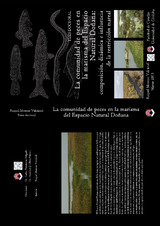Mostrar el registro sencillo del ítem
La comunidad de peces en la Marisma del Espacio Natural de Doñana: composición, dinámica y efectos de la restricción mareal
| dc.contributor.advisor | Fernández-Delgado, Carlos | |
| dc.contributor.advisor | Oliva Paterna, Francisco José | |
| dc.contributor.author | Moreno Valcárcel, Raquel | |
| dc.date.accessioned | 2015-04-20T13:25:09Z | |
| dc.date.available | 2015-04-20T13:25:09Z | |
| dc.date.issued | 2015 | |
| dc.identifier.uri | http://hdl.handle.net/10396/12683 | |
| dc.description.abstract | Estuaries and marshlands are regarded as one of the most productive and threatened ecosystems in the world. A diverse community of organisms inhabits these areas that are able to cope with the natural variability characteristic of these tidal areas. Specifically, marshlands are considered important habitats for fishes due to their important role in the different aspects of their lives, such as feeding, reproduction, nursery grounds and pathways for migration. Those zones provide a wide range of goods and services to humans, such as natural protection of the coast against storms and floods, maintenance of water quality, water detoxification and filtering, support for tourism and other cultural and spiritual activities, etc. Additionally, marshlands are considered among the most productive ecosystems due to high nutrient concentrations and efficient energy cycling, and high biological productivity provides an abundance of food resources. The areas adjacent to marshlands are important navigation routes, therefore, marshlands and estuaries have historically been the most populated zones in the world. In spite of all the services that estuarine areas provide to human beings, these areas are under a great deal of human pressure that notably affects their functions and characteristics, and currently estuarine zones are among the most heavily used and threatened natural systems globally. During long periods in history, wetlands have been considered unhealthy and dangerous places, and humans have tended to dry and transform these lands, using them mainly as croplands. Fortunately, this perception has changed in the last few years and humans have realized that the loss and decline of these wetlands reduces their ability to produce goods and services for mankind. Estuarine areas suffer other important stressors now, such as the introduction of exotic species... | es_ES |
| dc.format.mimetype | application/pdf | es_ES |
| dc.language.iso | spa | es_ES |
| dc.publisher | Universidad de Córdoba, UCOPress | es_ES |
| dc.rights | https://creativecommons.org/licenses/by-nc-nd/4.0/ | es_ES |
| dc.subject | Ictiofauna | es_ES |
| dc.subject | Icthyofauna | es_ES |
| dc.subject | Parque Nacional de Doñana | es_ES |
| dc.subject | Doñana National Park | es_ES |
| dc.subject | Parque Natural de Doñana | es_ES |
| dc.subject | Doñana Natural Park | es_ES |
| dc.subject | Área Natural protegida de Doñana | es_ES |
| dc.subject | Doñana Natural Protected Area | es_ES |
| dc.subject | Marismas de Doñana | es_ES |
| dc.subject | Doñana Marhlands | es_ES |
| dc.title | La comunidad de peces en la Marisma del Espacio Natural de Doñana: composición, dinámica y efectos de la restricción mareal | es_ES |
| dc.type | info:eu-repo/semantics/doctoralThesis | es_ES |
| dc.rights.accessRights | info:eu-repo/semantics/openAccess | es_ES |

